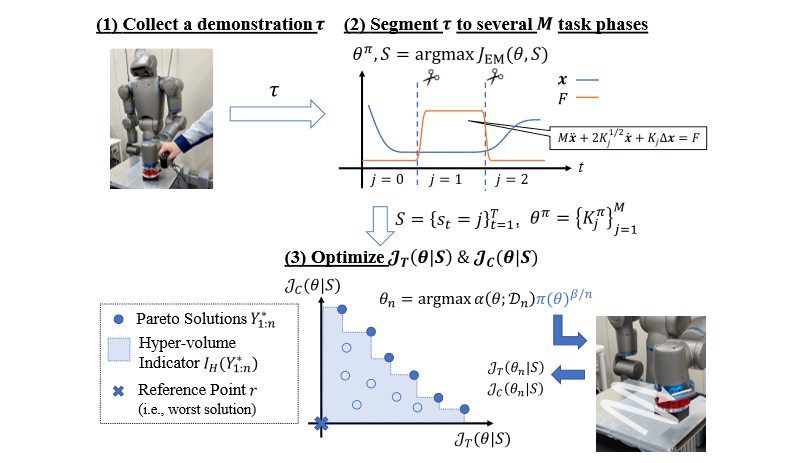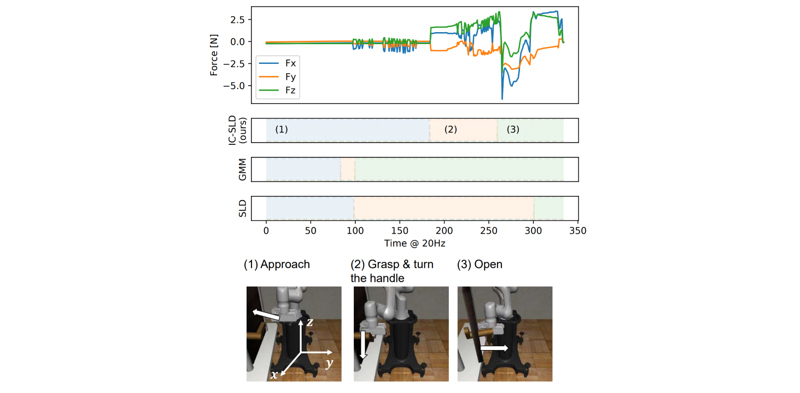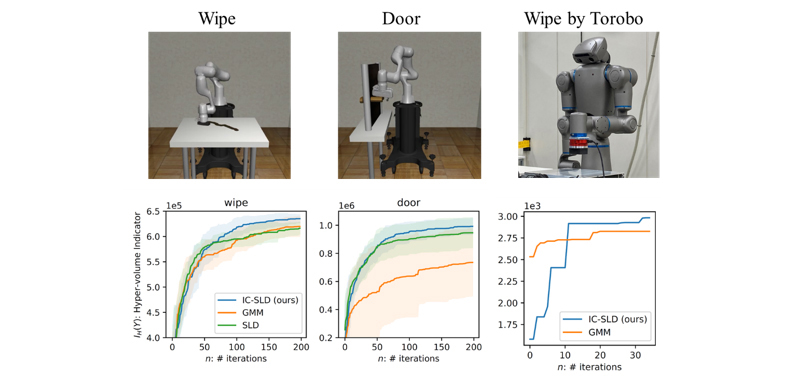Technology to streamline motion teaching for robots
Panasonic Holdings Corporation has developed a new technology that can teach robot motions that includes contact with the surrounding environment (doors, tables, and more), control parameters that achieve both performance that correctly completes the taught motion and safety during contact.
As the use of industrial robots advances, technology for efficiently programming robot movements is becoming more important. In particular, in environments involving contact with people and objects, movements that reduce the risk of contact while performing tasks accurately are required, but robot control that achieves both is known to be extremely difficult. Therefore, Panasonic has developed a method to efficiently program a robot assuming it behaves flexibly like a spring. It developed a novel method to learn stiffness parameters of impedance control to satisfy both task performance and safety requirements by segmenting the motions taught to robots demonstrated by humans and multi-objective Bayesian optimisation.
The advancedness of this technology has been recognised internationally, and it has been accepted to the IEEE/RSJ International Conference on Intelligent Robots and Systems (IROS) 2023.
It will be presented at the plenary session to be held in Detroit, Michigan in the USA from October 1 to October 5, 2023.
Overview
Direct teaching, in which humans directly teach robots movements, is widely used as a method of programming robot movements because of its simplicity. However, when a robot reproduces a taught action in an environment where there is contact with objects or where people or other robots cooperate or divide labour, it becomes necessary to deal with the risk of unforeseen contact in order to avoid damage to people, objects, or the robot itself, making it difficult to utilise robots for certain tasks.
In the field of control technology for flexibly moving robots, there is impedance control, which mimics a virtual spring system and gives the robot flexibility like a spring. If an appropriate spring system parameter (impedance gain) is set, it is possible to reduce the risk of contact while having the instructed operation performed accurately. However, with impedance control, there is generally a trade-off between safety and motion accuracy, and it is difficult to set an impedance gain that optimises both at the same time.
Also, in order to achieve the desired task, it is necessary to accurately perform multiple consecutive actions. For example, in the case of opening a door, the robot must 1) approach the knob, 2) turn the knob, and 3) open the door. However, optimum impedance gain differs for each operation.
Therefore, as shown in Figure 1, a method was developed that first segments a series of motions being taught to facilitate parameter optimisation, and then finds the optimal impedance gain for each segment using multi-objective Bayesian optimisation.

Figure 1: Flow of learning impedance control parameters with the newly developed method. Photographs and segmentations illustrate the table wiping task done by an actual robot. Quoted from Fig. 1 of the accepted paper.
Subsequently, the impedance gain is explored through Bayesian optimisation using prior knowledge. Since IC-SLD also outputs an estimated value of the impedance gain, using this as a solution candidate makes optimisation more efficient. By applying Bayesian optimisation π-BO [Hvarfner+,ICLR2022] that is able to make use of prior knowledge, optimal impedance gains that simultaneously optimise task performance (the cumulative sum of reward functions) and safety indices (the cumulative sum of stiffness parameters) are searched while repeating robot motion trials.
Experiments on simulated tasks and a real robot demonstrated that our method allows for learning the impedance gain in a shorter time than the conventional method.

Figure 2: Segmentation results for the door opening task performed using IC-SLD and the conventional method. Quoted from Fig. 4 of the accepted paper.

Figure 3: Learning results of impedance gain in simulation and actual equipment using the newly developed method. The horizontal axis is the number of trials, and the vertical axis is an index that combines task performance and safety. Quoted and processed from Fig. 3 and Fig. 8 of the accepted paper.
The newly developed robot teaching technology accelerates the use of robots in environments where they collaborate with human. We will continue to accelerate the social implementation of AI and robotics and promote the research and development of AI technology that contributes to our customers' lives and work sites.











